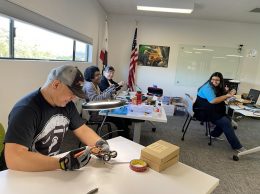Ring of wire: Digital West lays first fiber lines in SLO
Digital West Networks has laid a stretch of fiber optic cable along the South Higuera Street business corridor in San Luis Obispo, the third phase in its effort to build a “fiber ring” around the Central Coast city and deliver some of the fastest business connectivity in the region. The company also plans to march north to Paso Robles by early next year.
Digital West is known to the wider world as a data center company with facilities in San Luis Obispo, San Jose and Los Angeles where technology firms can stash their important data in multiple locations in case one is cut off by a natural disaster or other network interruption. But in recent years the firm applied for and received interexchange carrier status, a regulatory designation that lets it lay fiber-optic cable underground or hang it from poles.
Digital West has used its new status — along with a loan from the U.S. Small Business Administration, some long-term contract commitments from customers and some creative partnerships with city and county officials — to wire San Luis Obispo up with fiber. It has reached nearly all of the city’s main business corridors and has plans to extend its efforts over the Cuesta Grade to Paso Robles.
“It’s going to allow us to really connect a lot of the businesses in the region, many of them who have been without any kind of high-speed connectivity for a long time,” said CEO Tim Williams.
The new line extends along South Higuera Street. There’s already a hot line from the downtown core of San Luis Obispo along Broad Street to near the airport at the intersection of Buckley Road. Eventually, the lines will extend all the way from downtown along Higuera and use Buckley Road to form a ring. The speeds are up to a gigabit up and down, compared to the 60 to 100 megabits that are common for business connections.
“There’s no need for us to slowly, over time, add more hardware. The fiber we’re delivering is the backbone — it’s the fastest they can get,” Williams said.
The reason that most business corridors in the Tri-Counties don’t have access directly to fiber is that it is very expensive to lay fiber lines. To mitigate the cost, Digital West used a Small Business Administration loan to get started. It also pre-signed contracts to deliver fiber with about two dozen businesses. Then, it looked for opportunities to team up with the city, county, Cal Poly or whoever else might be moving dirt to lower costs.
For the recent stretch of fiber, Digital West agreed to provide some storage and backup services for the city of San Luis Obispo and lay some fiber for the city in exchange for access to a city-owned underground conduit. “The city has been pretty forward-thinking in terms of the conduit network that we’ve laid over the past dozen years or more,” said Michael Codron, assistant city manager. “In this case, there was a great synergy between what private business wanted to accomplish and what the city’s needs were. It took a lot of work together with Digital West to find a model that would work for a public-private partnership, but we did it through essentially an exchange of services. I think we want to do more of it in the future.”
Williams said Digital West has also leased “dark fiber” — unused fiber lines laid by major carriers — to extend its services to Paso Robles. West said the core of larger businesses near the Paso Robles Airport on the east side of the city are a prime target for services. Digital West is hoping to build a huge data center in San Luis Obispo but is working closely with Pacific Gas & Electric to find a property where it could draw the massive amount of electricity it would need — 22 megawatts. That much power can’t be delivered on normal infrastructure.
“In comparison, the entire Cal Poly campus is eight megawatts,” Williams said. “We don’t need that 22 megawatts from day one, but we definitely need to know we can get it if we need it.”
Eventually, Digital West is hoping the data center and all the fiber it is laying will help it tap into an extremely valuable and extremely unique Central Coast resource: direct onramps to trans-Pacific Internet backbone landing stations.
In San Luis Obispo County, major backbone lines come ashore that connect the West Coast of the United States to China, Japan, the South Pacific and South America. Digital West’s long-range goal is to give businesses in San Luis Obispo County some of the fastest connections to Asia from the United States. “Each step we take toward building our fiber ring brings us closer to building onramps to those landing stations,” Williams said. “Our goal is to connect to all three, and we should be connected to the first one right around the beginning of next year.”











